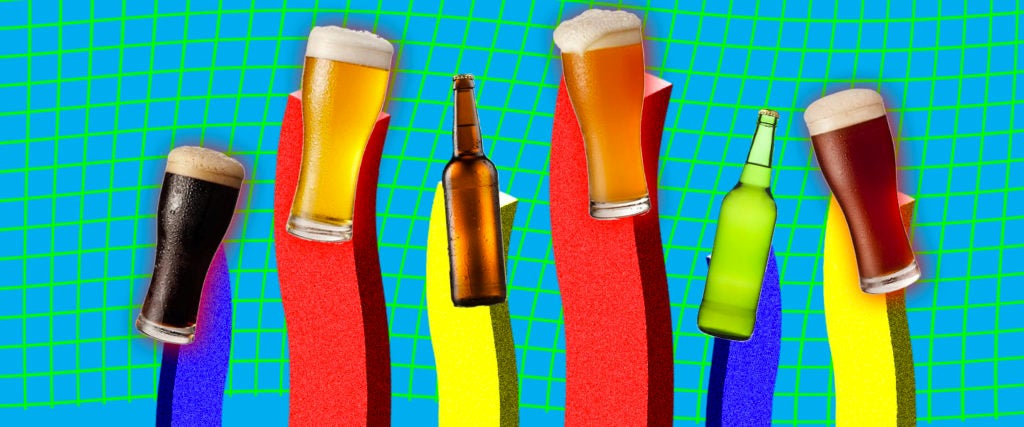Let me preface everything to come by saying that I’d drink beer all day and all night if it wasn’t for the fact that, apparently, that’s not so good for the whole staying-alive-and-healthy thing (and probably also not so good for being a decent, functional, not-permanently-drunk human being). Apart from the belligerent, drunken tantrums that come with slamming ales like I just spent 40 days in the desert without water, I also know that drinking too much suds will inevitably expand my stomach (and obliterate my precious liver).
So yeah, avoiding too much beer is always a good idea, for more reasons than one. But for many, a life without beer is a life without joy. So to figure out which beer you can drink the most of without having to live life permanently in sweatpants, I asked Dana Hunnes, senior dietitian at the Ronald Reagan UCLA Medical Center, to help me rank popular styles of beer by how unhealthy they are, from least unhealthy to most unhealthy.
But first, know that this ranking wasn’t quite as simple as our previous rankings. “This one is a little trickier because the biggest defining differences between any sort of beer are their alcohol contents and carbohydrate contents, as well as their calorie content (which is determined mostly by their alcohol content and carbohydrate content),” Hunnes explains, adding that other subtle variations might arise from differences in filtering, fermenting and coloring. “I can’t say for certain that darker means healthier, but I still believe that to be the case, because darker beers possibly contain more vitamins and minerals.” Also know, however, that darker beers tend to contain more calories.
But most of all, Hunnes emphasizes that beers with higher alcohol contents are (perhaps obviously) the most unhealthy. “Let’s be real here — alcohol is alcohol,” she emphasizes. “Since beers can vary by alcohol content, one beer can (at times) be considered to be one-and-a-half drinks or even two drinks if its alcohol content is high enough.” Once again, high alcohol contents also typically correlate with high calorie contents and high carbohydrate contents.
All of which means that — shocking news! — you should opt for less alcoholic beers if you want to mitigate the damage.
With that, let’s rank some styles of beer…
1) Non-Alcoholic Beer: You saw this one coming, but what the hell. “Non-alcoholic beer is the healthiest with the fewest calories,” Hunnes says. “It also presents the least risk of overdosing on alcohol.” As an added benefit, when the hops, barley and yeast normally found in beer are untouched by alcohol — as is the case in non-alcoholic beer — they actually present some surprising health benefits, as we learned previously while researching an article about the validity of non-alcoholic beer as a post-workout recovery drink:
“Hops has been noted to help treat anxiety, insomnia, indigestion and muscle tension — all things that plague athletes,” says Ryan Greene, an osteopathic physician and diet and fitness coach in L.A. “Barley is commonly used for diarrhea, gastritis, inflammatory bowel syndrome, and has also been known to lower blood sugar, blood pressure, cholesterol and promote weight loss. It’s an excellent source of vitamins, carbohydrates, protein and fatty oils. Another principle component, brewer’s yeast, is well-known as an excellent source of chromium, B complex vitamins, protein and selenium, which helps with the function of your liver and thyroid. So all those things together, you can certainly consider non-alcoholic beer a post-workout beverage.”
Did we also mention that, for some, non-alcoholic beer makes sober life worth living?
2) Light Beers: “This doesn’t have much going for it,” Hunnes says. “I mean, it has less alcohol than regular beers, which means fewer calories and less likelihood of overdoing alcohol, but it also tastes like watered-down beer.” On a positive note, light beer (such as Coors Light) can apparently bring families together.
3) Stouts and Porters (tied): Hunnes once again explains that dark-colored beers (like Guinness) traditionally contain more vitamins and minerals; however, she also notes that they usually have a higher alcohol content, which we already know to be bad news.
4) IPAs: The only reason Hunnes lists IPAs before the many styles of beer that come next is because, “It has more hops, which might have some additional antioxidant capacity, than some of the beers listed below.” In fact, a 2015 study found that the hops in beer can help ward off dementia and other cognitive decline (although, drinking too much of it may very well do the opposite).
5) Lagers, Wheat Beers, Ales, Pilsners, Ambers, Blondes (tied): Hunnes says that these are all relatively equal in terms of unhealthiness — your best bet, if you want to pick the healthiest option among these beers, is to simply check the labels for their alcohol contents.
But healthiest or otherwise, Hunnes has one final message for all of us beer drinkers: “Just remember to drink responsibly,” she emphasizes. “For some people, there may be no safe level of alcohol consumption. But if you’re going to drink, it’s recommended that you consume no more than one drink per day for women, and two drinks per day for men.”
Which seems completely realistic! Now excuse me while I cry in the corner, contemplating my next sober month.

